With Sea of Thieves finally out, Microsoft has officially released four (as well as Fallout 4 next-gen versions releasing) Xbox console exclusives on the PS5 and other platforms; no longer making them exclusives. While there’s a hot debate happening between fans of each console, I wanted to divert some attention to one of the biggest concerns that PlayStation had about Microsoft owning Activision and the Call of Duty franchise, and that was that they believed that Xbox would deliberately release a buggier and inferior version, pointing out to things like visuals, performance, and even not making use of some of the exclusive features found on the PS5.
While it’s still too early to say whether that statement will come true for the Call of Duty series, we may have been given a small glimpse of that support with some recently ported Xbox exclusive titles. Early signs suggest that Xbox Game Studios is making good use of the horsepower under the PS5’s hood; however, the same cannot be fully said about those “advanced” exclusive features that PlayStation was concerned with. What advanced features? Well, those are provided by the DualSense controller, such as advanced haptic feedback and adaptive triggers.
With five Xbox titles being ported to the PS5 in the last few months, let’s examine how each studio has enhanced its games using the DualSense controller.
Feeling the Beat – How Tango Gameworks Takes Advantage of Haptics in Hi-Fi Rush
While not the first Xbox game to make the jump to PlayStation (that belongs to Pentiment), Hi-Fi Rush is perhaps the most exciting of the bunch, as it’s a title that many could agree is perfect for the PlayStation fanbase. It is an original story-driven single-player with stellar gameplay, music, and visuals. It was a masterpiece on Xbox and is still very much one on the PS5. But while both versions remain practically the same, the now defunct game studio, Tango Gameworks, has gone the extra mile for the PS5 version, ensuring that the game looks and runs excellently on the platform while fully utilizing the DualSense features.
Believe it or not, developers have used several techniques for haptic feedback in games. They may not be as apparent because who’s paying attention to them while playing a game? But there are a few standout titles out there that many have openly appreciated, such as Returnal, Astro’s Playroom, Ratchet and Clank: Rift Apart, and others.
Have you ever wondered why they stand out so much compared to many other games, though? Well, that was something I’ve dove into before with my Astro’s Playroom and Insomniac Game pieces, but the short of it is, these games and the studios behind them aren’t looking at haptics as just another form of rumble in a game. They’re looked at from a perspective of how they can improve the player’s experience through the sense of feel.
Take rain. In Astro’s Playroom and Returnal, players can feel individual droplets landing on a character through the DualSense’s haptic motors. Stuff like wind blowing, a lightsaber and its hum, the feeling of metal being struck, so much can now be felt because of haptics, but only if a studio does the work at emulating such things.
It’s not just about outputting in-game sounds either because not everything feels like how it would sound if that makes any sense. Maybe a loud pitch has a violent tremble, or it doesn’t. Maybe something doesn’t have an audible sound, but if you held it, you could feel the certain vibrations it’s making. Like a heartbeat, you can’t hear it unless you get super close to your heart, but if you put your finger on your neck, sure enough, you can feel it.
These games take that into consideration: things that you can feel but not necessarily always hear. To provide that feel, they need to create a vibration that would produce it, which, at times, can be audible from the controller. I always like using the Pixel Gun from Insomniac Games’ Ratchet and Clank: Rift Apart to show this: what you hear in-game isn’t always what the DualSense haptics always produce.
Unique audio cues are created for specific actions, providing unique feedback through the controller.
Tango Gameworks follows that example of implementation. Rather than throwing in the same vibrational tile set from the original Xbox and PC releases, the studio has rebuilt the entire game for the haptic experience on the PS5 (and updated the PC version with DualSense support).
Scenes have been enhanced, meaning you will no longer get a standard rumble that produces patterned vibrations like a massaging machine. Instead, each vibrational cue will attempt to emulate what an object might feel during a specific action.
Because Hi-Fi Rush is a rhythm game where nearly every sound is meant to accompany another for a musical mash-up, controller vibration is an excellent way of getting the players more involved. With the DualSense, it feels like you are holding a jukebox as every beat tries to emulate a unique tone. It’s not just patterned vibration you feel; it’s part of the game’s music, whether during cutscenes or in combat.
Again, I want to point out that this isn’t just Tango Gameworks overlaying data on top of the existing information. One of the significant benefits of DualSense’s motors is that they can read more and output on a far larger and even smaller scale. Many of these smaller-scale ones come in the form of things such as Chai tapping his feet and snapping his finger, and even when his weapon is assimilated, you can feel the individual clicks and stomps rather than one continuous vibration.
Because the DualSense can provide short burst feedback like a finger snap, there are now several instances throughout Hi-Fi Rush that have more vibrational feedback going on. Mind you, they’re small, but it’s those small details that, when added up, really do make for a better experience.
To give you an idea of how much more has been added, comparing the opening scene of the Hi-Fi Rush of both the Xbox and PlayStation versions, I counted how many times the controller vibrated. To verify my count, I laid both controllers down and connected a mic to them to record every instance they vibrated. This allowed me a more accurate count as it could be brought into an editor with a visible timeline. What I considered a count was any instance that the motors in the controller would go nearly completely silent, even if it were for a split second. A visual timeline from a short sample allowed me to verify when these dips would happen, which is further explained in this image.
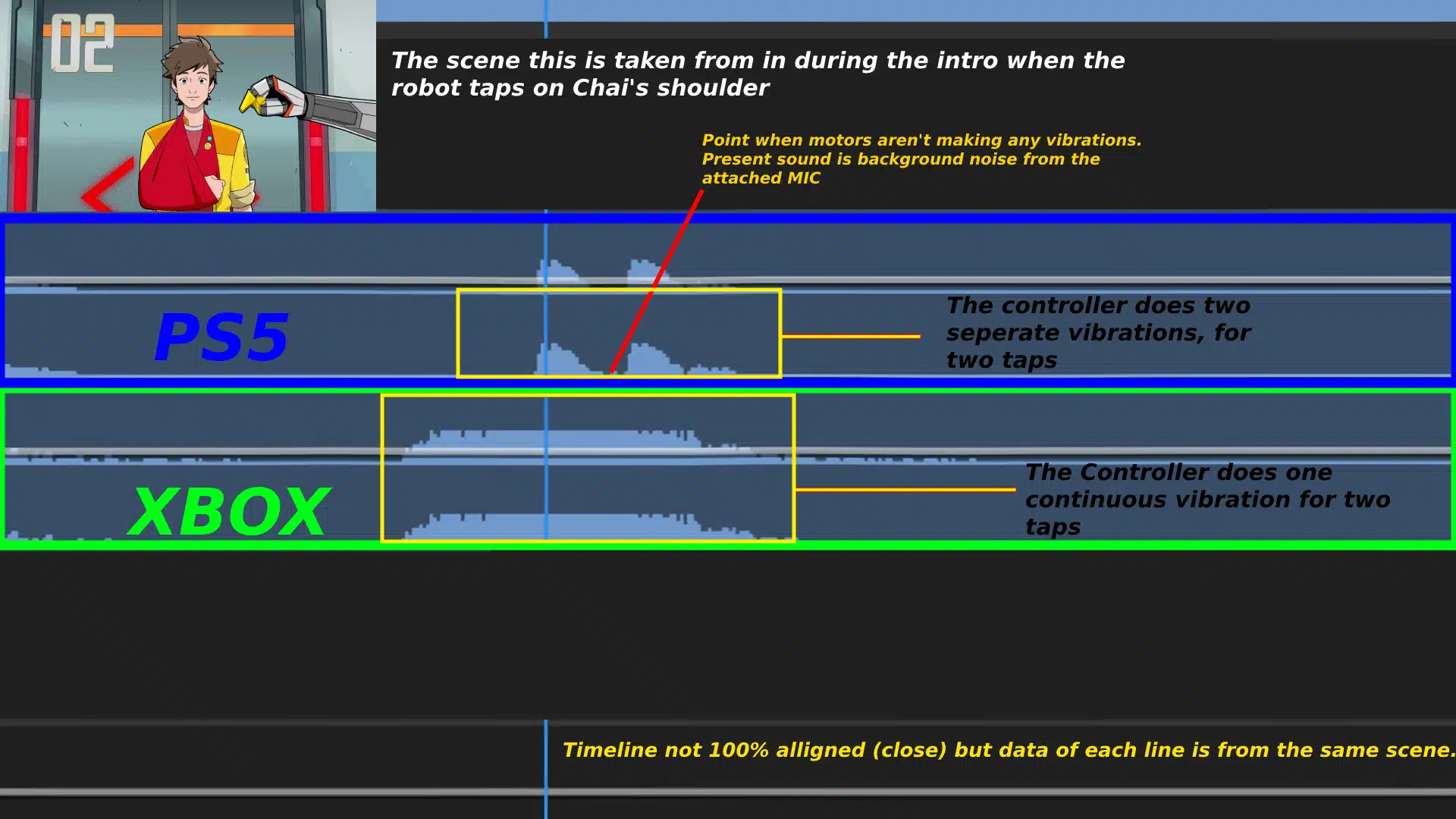
So here’s my count for the intro alone:
- Xbox Series: 17 times the controller vibrates
- PS5: 34 times the controller vibrates, a mix of multiple cues playing during those 17 vibrational scenes in the Xbox version, with eight scenes now having feedback not present in the Xbox version, as shown below.
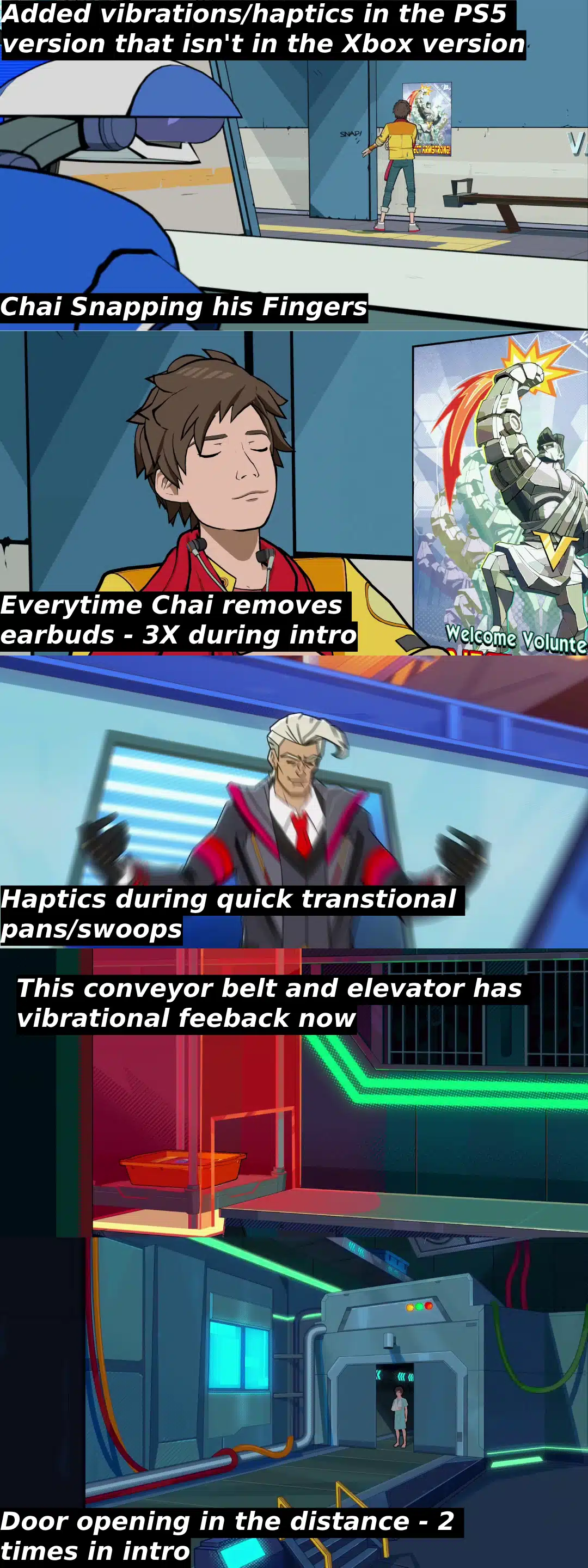
Here’s a short comparison with audio to give you a better idea of what’s going on with the controllers on each platform. There’s no sound on the Xbox version in the first part because there’s no feedback to capture from the controller during this specific scene.
I won’t go through the entire game to note all the differences between the two versions. There are plenty of examples above to show some of those differences, and trust me, the game itself has loads and even far more noticeable moments.
I just found it cool to see a now-owned Xbox studio putting in the effort to make some of those exclusive PlayStation features shine in their game. To be fair, Tango Gameworks did work on Ghostwire Tokyo, which started as a PS5 exclusive, and both games share the same audio programmers, so there is experience being carried over here. Still, Hi-Fi Rush was initially built for the Xbox and PC, with the PS5 port being developed after those releases.
The studio uses some cool little techniques, such as distance feedback for vibration. That’s also present in the Xbox version, though the DualSense’s haptics makes it more noticeable in some scenes.
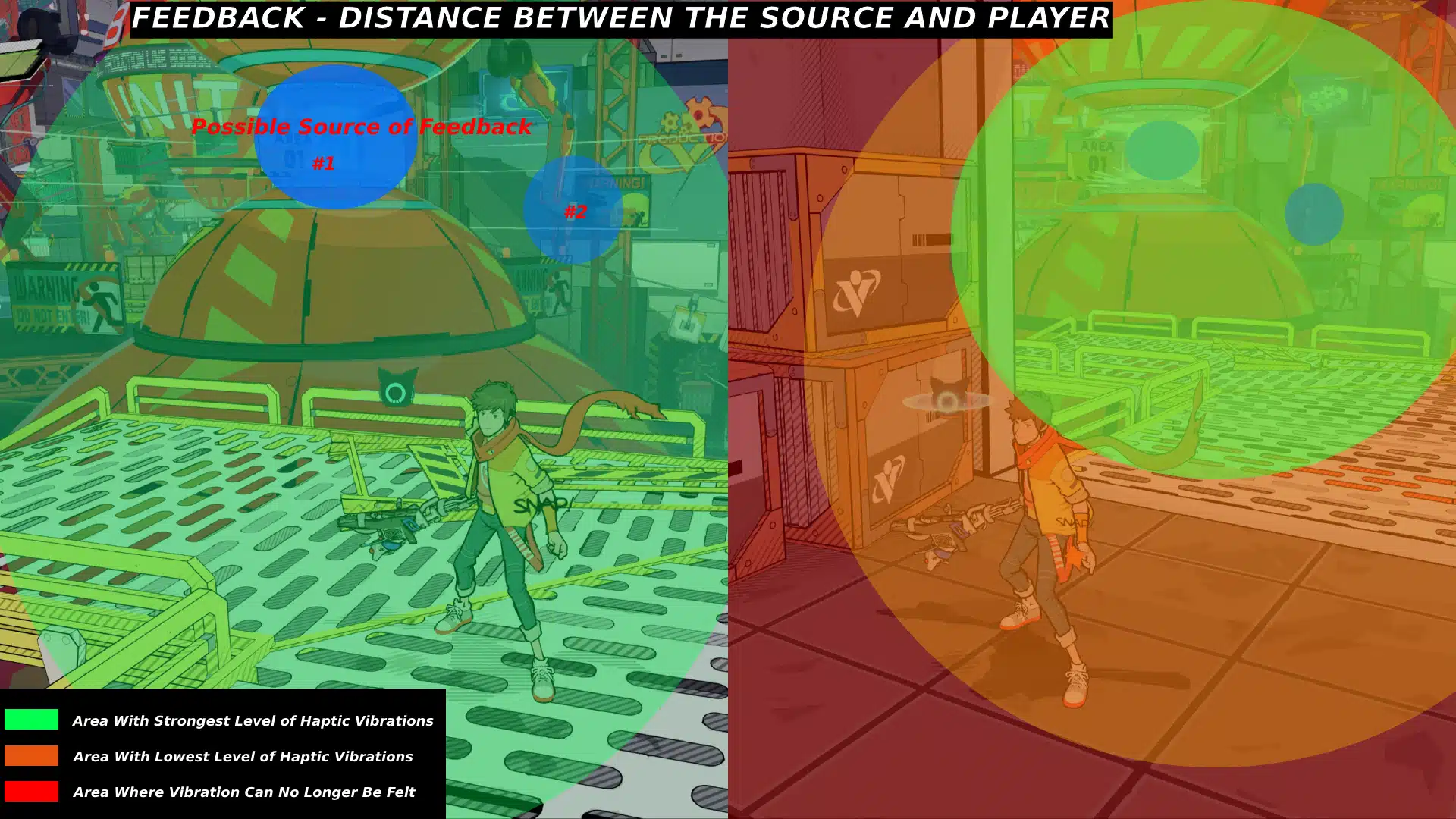
It’s not so much on a graphical and performance scale that players should be left impressed with the PS5 version of Hi-Fi Rush, because, after all, outside of better shadows, as Digital Foundry concludes, both versions of the games are near carbon copies of one another. However, if there are going to be any talking points about the most significant differences, it, in my opinion, should come down to how the controller performs on each platform.
By no means is the Xbox version terrible when it comes to rumble, and in fact, I quite enjoy the more violent, high-intensity moments in the Xbox version in some instances. But it’s hard to ignore what more the DualSense can bring to the table when immersing players with its unique and precise motors. There’s more going on in the PS5 version than the Xbox version; even when it’s not as high in intensity, it hits differently when those vibrations jolt through your hands.
Tango Gameworks deserves a ton of praise for the work done with this port, praise that is sadly overshadowed by the news of their shuttering earlier this month. It’s not just a blow to gamers but to Xbox overall, as not only did they close down a studio that produced one of their best games in recent years, but they’ve also closed down one of their best studios when it comes to working on the PS5 and its DualSense controller.
That becomes more apparent once you start looking at the other recent ports of titles, as the DualSense is left mostly ignored, and underutilized.
Sea of Thieves, Grounded, Pentiment, and Fallout 4, Where Do They Stand?
Initially, this piece was going to focus only on Hi-Fi Rush. The reason was the lack of time and how close all these releases were, but after playing through Hi-Fi Rush entirely, it did get me more interested in visiting the other titles.
Before diving into each of them, I want to set a baseline. For Hi-Fi Rush, I am marking it as a 4/5 rating for using DualSense features, with the following breakdown.
Hi-Fi Rush DualSense Rating: 4/5
- Basic gameplay – Used during combat, with unique haptics for specific actions.
- Example – The feedback used when the character jumps is not the same as when the character swings their weapon, and different strikes have slightly different feedback.
- Environments – Many objects in the environment also have haptics, so you are not only feeling feedback produced from the character but also various things within the environment.
- Cutscenes and Cinematic Moments
- You would be surprised at the number of games offering little to no feedback during cutscenes. It’s always great to see a studio add more to its own cutscenes.
- Fully rebuilt for the haptic experience.
- I’ve listed and shown some examples of this above. Hi-Fi Rush isn’t just a quick port; Tango Gameworks did some real work, redoing the rumble experience and adding new cues throughout the game.
- There’s room for improvement, such as improving adaptive trigger uses. Still, Hi-Fi Rush makes fantastic use of DualSense, comparable to some of PlayStation’s first-party offerings and better than many other third-party offerings.

Pentiment – No Rating
I’m giving Pentiment a “no rating,” considering the kind of game Pentiment is. It’s you’re classic adventure game. There’s no combat; all the gameplay solely relies on the story and role-playing through it. So, while rumble and haptics can play an important role, I don’t think it would add much to the overall experience here for the kind of game that Pentiment is.
Mind you, there are many instances where haptics could have worked, such as being able to feel a boat crossing the sea, someone writing, drawing, painting, and so many other places, but I don’t think Pentiment is a game to expect much from on the DualSense front.

Sea of Thieves – 2/5
- Basic Gameplay – Many gameplay elements in Sea of Thieves use haptic feedback. They are on the lighter side, but there are plenty of them.
- Examples – These mostly revolve around actions on the ship, like reloading a canon ball, steering the ship, and adjusting the sail.
- Each gun looks to provide unique feedback, with adaptive triggers that also give you that pulling-of-the-trigger resistance.
- Environments – From my testing, it appears the only environmental feedback is from walking through bushes and such. There’s a slight bump every time you walk through them. There’s no terrain feedback, such as going from a sandy surface to hardwood. There’s no feedback from swimming, either, which is something I expected out of a game like this. Nitpick, sure, but Marvel’s Spider-Man 2 has feedback from swimming, and that’s something I bet most players don’t even do because of how pointless it is there, but it’s there.
- Cutscenes and Cinematic Moments – There is not much going on here if there is any feedback. I assume it’s the same on Xbox, where these scenes lack rumble, but it’s still a missed opportunity.
- Adaptive Triggers—Present, and as you would expect, they get used in weapons wherever tension and resistance are at play, and they are mapped on the triggers.

Grounded – 1/5
Grounded is the biggest disappointment of the exclusive (as it was not previously on PlayStation).
- Basic Gameplay—So far, the only feedback provided is when the character hits something with a melee weapon. Even then, it’s very hit-and-miss, and that feedback is nearly identical to the feedback given during menu navigation.
- Environments – As far as I can tell, there is zero environmental feedback. Character walking and their steps produce no feedback, no matter the terrain, a common haptic technique seen in plenty of other games.
- Cutscenes/cinematic moments
- Grounded is not heavy on cutscenes, with the intro being a video playback. There’s no feedback there, which is unsurprising, considering it’s not running in real-time.
- But the game does take you through some “cinematic” story moments where things play out, and even then, the use of the controller goes completely unnoticed.
- As far as I can tell, this is the bare minimum of support, if we even want to say that, when using the DualSense features. The experience barely differs from that of the standard rumble.
- Adaptive Triggers – Since the weapons in Grounded are mainly melee weapons, adaptive doesn’t offer much there. You typically see adaptive come into play when something in the game can provide recoil and resistance. There is a crossbow, but sadly, there is still nothing on the adaptive side.
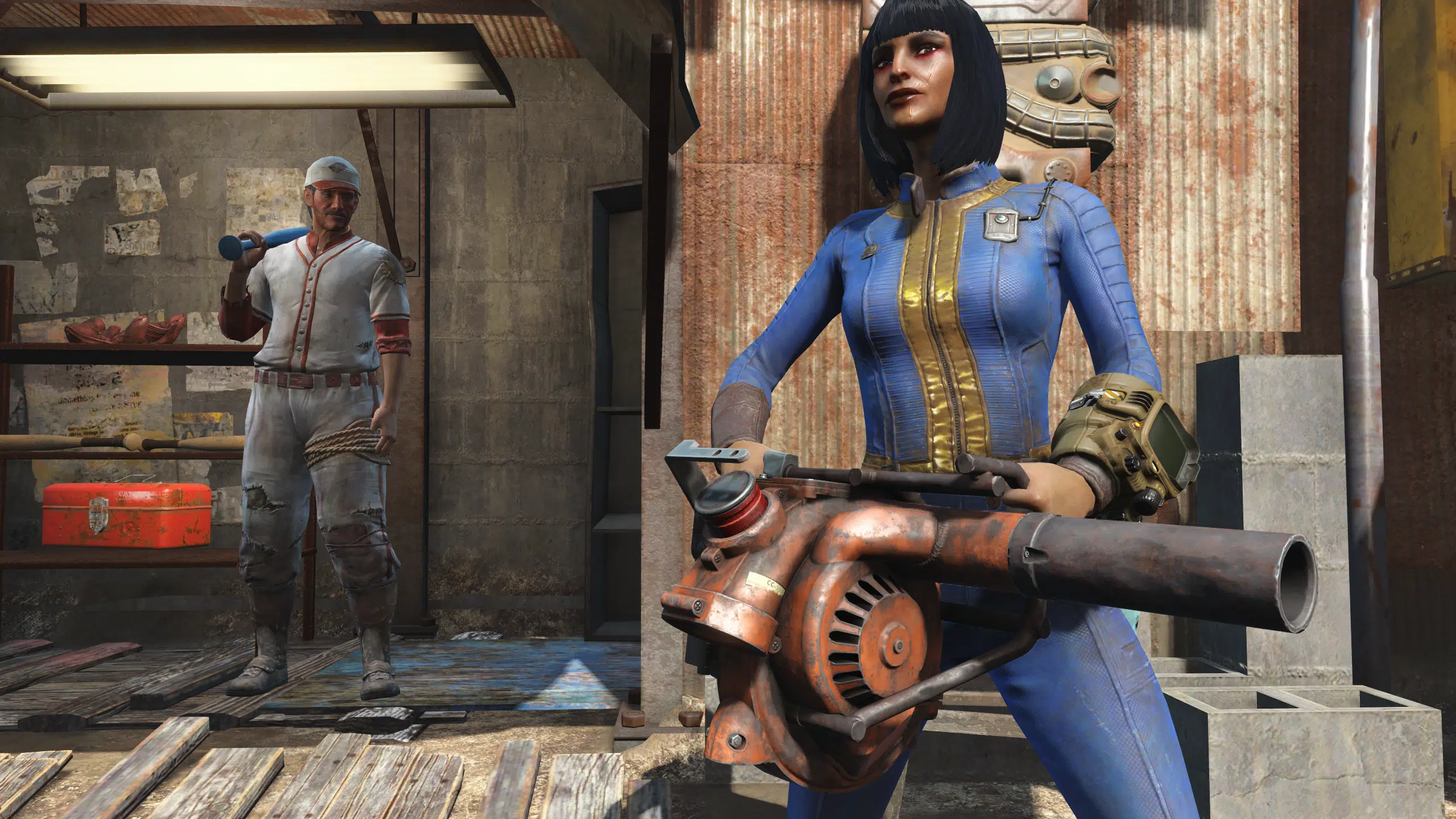
Fallout 4 – 0/5
This is my biggest disappointment of all the recent Xbox ports. I mentioned that for Grounded, but that title was never on PlayStation to begin with. Fallout 4 was on the PS4, with its next-gen port announced a year before Microsoft bought Bethesda.
There were a lot of expectations set with this port compared to the other releases, and with it now out, there’s been a lot of disappointment on all fronts on every platform. But looking at the DualSense, Bethesda has practically made ZERO effort to utilize it in any way.
Given the list of weapons, terrain, locations, enemies, elemental damage, and other stuff, you’d expect a lush amount of haptics and adaptive design for each instance. The reality is that no adaptive triggers are used on any of the available weapons or actions. Vibrational support is listed as the only DualSense-supported feature on the PlayStation storefront. Still, the lack of adaptive trigger support is disappointing, given how long this port took to get.
As for haptics, the game supports vibration, which is still considered haptic, but it’s not anywhere near what can be produced on the DualSense. From my testing, it’s very barebones. All guns have practically the same vibrational pattern and tones, just in short or longer bursts, which is the same pattern when you are hit with a melee weapon or get hit by an enemy, regardless of whether they use a gun or melee weapon. It’s nearly the same vibrational experience brought over from the PS4 version. It feels like no attempt was made to understand and use the DualSense to enhance the player experience in Fallout 4.
What Does the Future Hold?
It’s hard to say whether the studios under Xbox’s wings, which only made Xbox console games before the recent change, will improve when taking advantage of other platform features in the future. Early signs point to things being a bare minimum, with Tango Gameworks being the shining example of real effort being put into their release. But that example is one that comes with the experience of an audio team that previously worked on a former PS5 exclusive (Ghost Wire Tokyo), which made great use of the controller.
As of now, the only other known title that is coming from Xbox to PlayStation is Call of Duty Black Ops 6, though I will say that PlayStation gamers concerned with Xbox suddenly gimping the PS5 version by ignoring the DualSense probably shouldn’t have to worry. Sure, the previous examples may say otherwise, but the Call of Duty studios have been working with PlayStation hardware for decades.
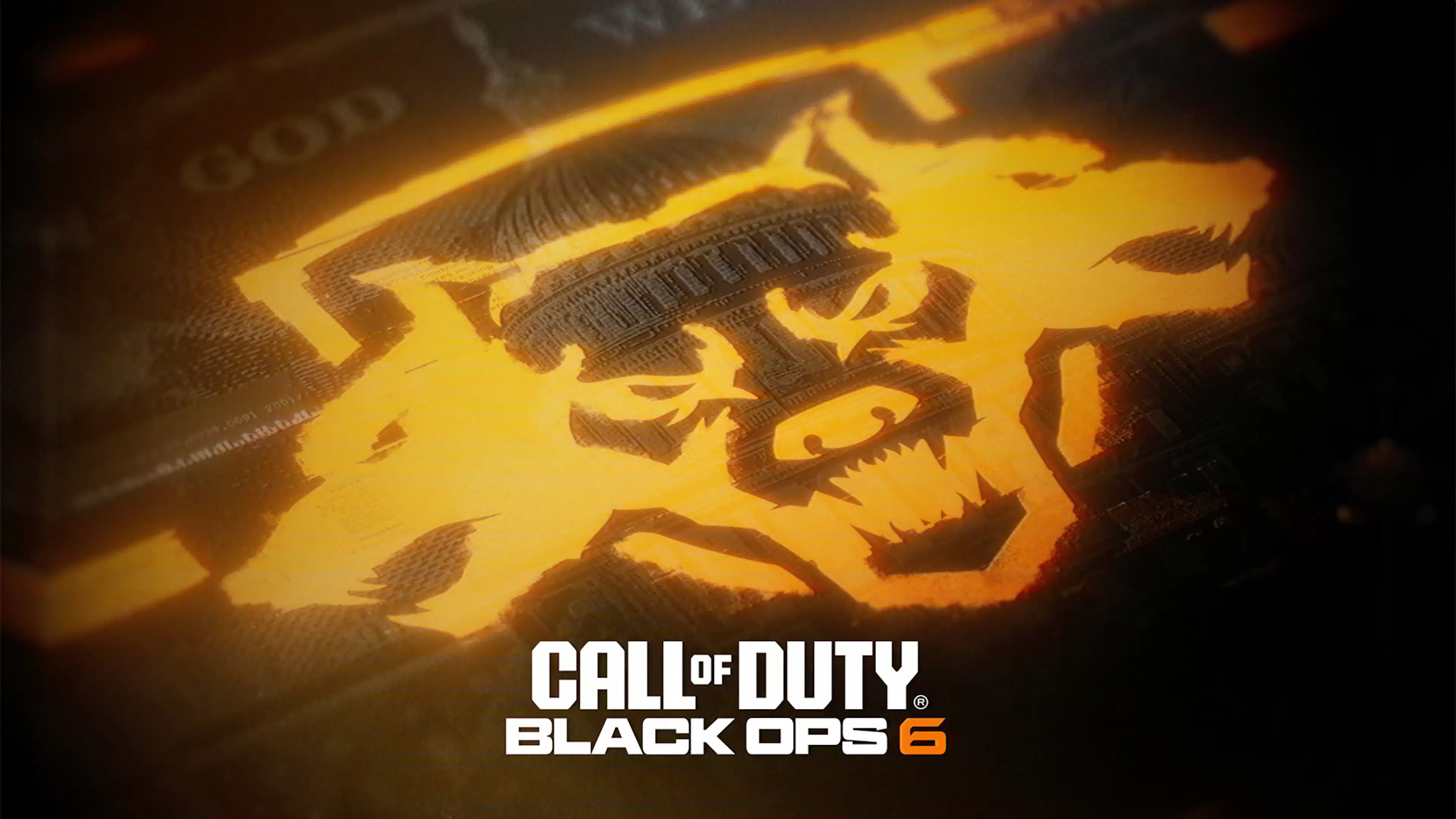
All current PS5 Call of Duty games have made tremendous use of the DualSense, and there’s very little reason to believe that Black Ops 6 won’t do the same, considering the experience is already there. However, it is something I’ll be checking out for myself once the game drops later this year.
That said, other potential Xbox exclusives coming to PlayStation may be a different story, as evidence suggests that the advanced exclusive features offered by the PS5 are going mostly unnoticed. That could change, but beyond those ports running well, I would temper expectations for future ports when it comes to taking advantage of the DualSense features.
If Xbox were to ever upgrade their controller with haptic motors comparable to or better than those in the DualSense, it may not be a bad idea to support the controller more themselves, as that would at least allow them to have a good amount of Xbox games ready to take advantage of that new controller.
